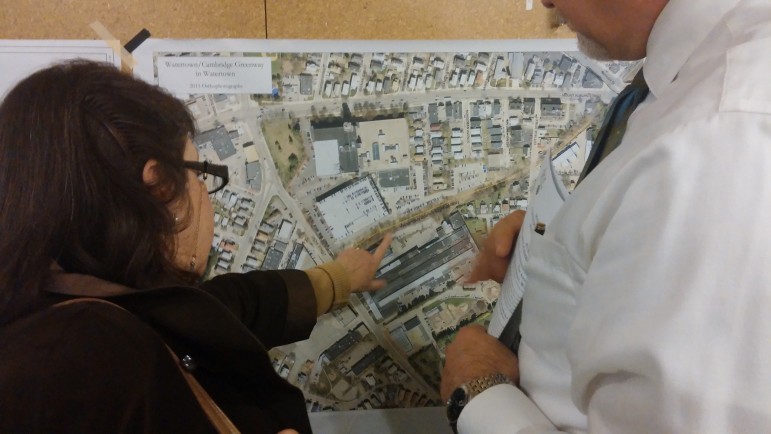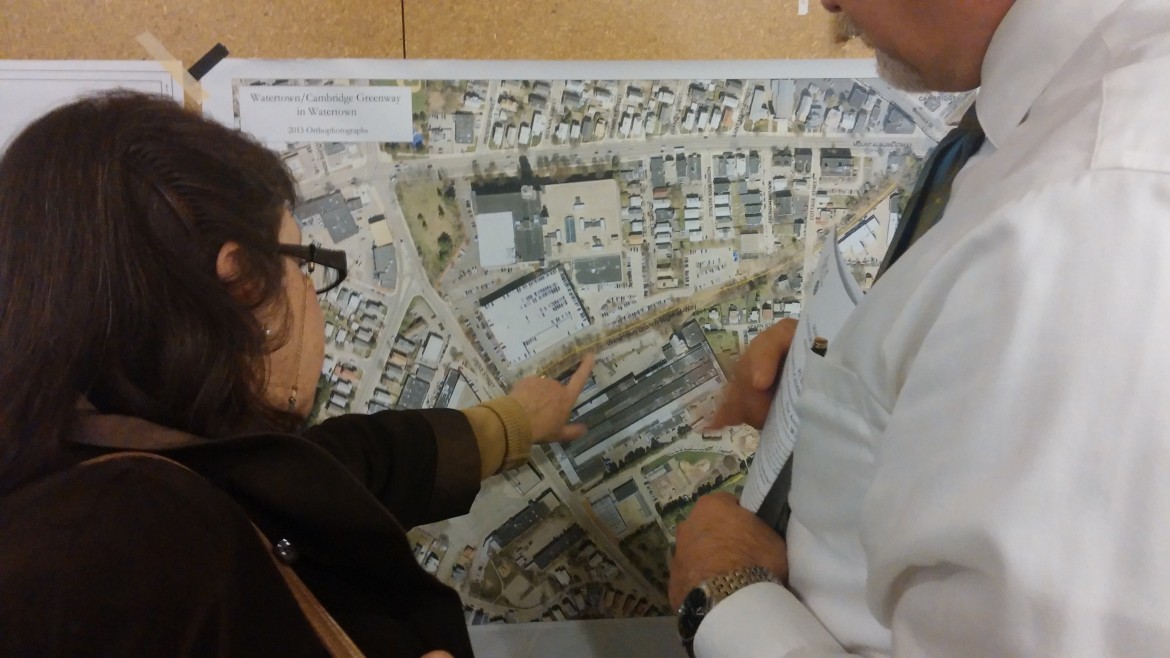
Charlie Breitrose
East End Councilor Angeline Kounelis, left, and Assistant Town Manager Steve Magoon look at a map of the new section of the Community Path from Watertown to Cambridge.
Residents wanted to see more access points to the bicycle and pedestrian path from Watertown to Cambridge and some worried about the safety of the path along the former railroad line at night.
Dozens of interested residents from Watertown and Cambridge packed a room at the Atrium School Monday night to learn about what the Phase 2 of the Community Path (also called the Watertown-Cambridge Greenway) from Arlington Street to Fresh Pond will look like.
Officials from the Department of Conservation and Recreation showed their preliminary plans for the new section of the path, which starts at Arlington Street near Nichols Avenue and Crawford Street, runs into Cambridge and ends at Fresh Pond.
“People will be able to get around between Cambridge and Watertown a lot better,” said Dan Driscoll, director of Recreation Facilities Planning for the DCR. “There are still a few issues to work out but it is going to be a great project.”
The path would connect the path that opened in 2010 between School Street and Arlington Street, running behind the Watertown Mall. It will be 12 feet wide, with two-foot shoulders on either side. There would be entry points from Arlington Street and Cottage Street in Watertown, and another one on Holsworthy Place in Cambridge.
Watertown residents at the hearing said they would like to see the path open as quickly as possible. Some wondered how people would get from the end of one section of the path to the other across a tricky intersection at Arlington Street, Crawford Street and Nichols Avenue.
The lights at the intersection have been sequenced to allow people to get to the other by making two signaled crossings, Driscoll said.
Entryways
Several people asked for another access point to the path in the trenched section of the former rail line up to the intersection of Mt. Auburn and Belmont streets, near the Star Market, Greg’s Restaurant and Sofra Bakery
Driscoll said this is a difficult place to make an entrance because of the steep sides of the trench, and the fact that entryways must meet the ADA’s handicap accessible standards.
Other entries might be possible, Driscoll said, but because the DCR and City of Cambridge only own the rail bed, they will have to work with private landowners to create more access points. They may approach Star Market to have access to the path from their property, Driscoll said, and others have approached the DCR.
“Tufts Health Plan wants to connect to the path, and even invited the public to come through their property from Grove Street,” Driscoll said.
Lights
Most of the path will be unlit, but the tunnel under Mt. Auburn Street will have lighting at all hours because it is so dark, Driscoll said.
Steven Bercu of the Boston Cyclists Union encouraged the DCR to put light along the length of the path to make it more safe for people to ride or walk on the path at night.
“You leave out people – women, children, elders – if you do not design it to light the path,” Bercu said.
Other residents said they would be worried about using the path at night if it was not lit, especially with few entry points.
Driscoll said the DCR does not light paths. Historically, all of its facilities are open from dawn to dusk, with the exception of people moving through the parks (walking, running or biking). Adding lights would also be difficult for the DCR, Driscoll said, because it has little land to work with, and solar lights would not likely work because the path is very shaded.
There is an option, he said.
“If the City of Cambridge wants to light that section we don’t have jurisdiction. But if they want to shine lights down on the path and pay for the cost, we can’t stop them,” Driscoll said. “As far as the expense (of lighting) the path going toward Watertown, that is 100 percent on the DCR’s shoulders.”
He warned that any additional costs would increase the tight budget, and could delay the project. It will cost about $1.4 million.
The designs have been paid for by $90,000 in donations from a number of sources: athenahealth, Boylston Properties, the Watertown Community Foundation, the Solomon Foundation and an anonymous donor. The DCR matched it with $90,000.
Next Steps
State Rep. Jonathan Hecht, who represents both Watertown and North Cambridge, said he wants to see the path completed soon, and said a packed room of supporters will help he and State Sen. Will Brownsberger make the case for funding the project at the State House.
“In Phase 1, the right of way was purchased in 2000 but was not built until 2010. This was purchased in 2013,” Hecht said. “Here we are two years later. We are moving a lot faster. I, for one, am not willing to wait another 8 years.”
The project is currently at the 25 percent design phase, Driscoll said. The current schedule calls for the 50 percent design to be reached in February 2016. The next public meeting will be held at the 75 percent design phase, in March 2016. The DCR hopes to have plans finished by spring or summer 2016 and construction to begin in the fall of 2016, pending funding.
To see the DCR’s presentation and maps of the project click here. The public can submit comments on the project until Dec. 22, 2015 by clicking here, or writing to the DCR Office of Public Outreach, 251 Causeway St., 6th Floor, Boston, MA 02114. Questions and concerns can be sent to Mass.Parks@state.ma.us or call 617-626-4973 or write to the address above.
